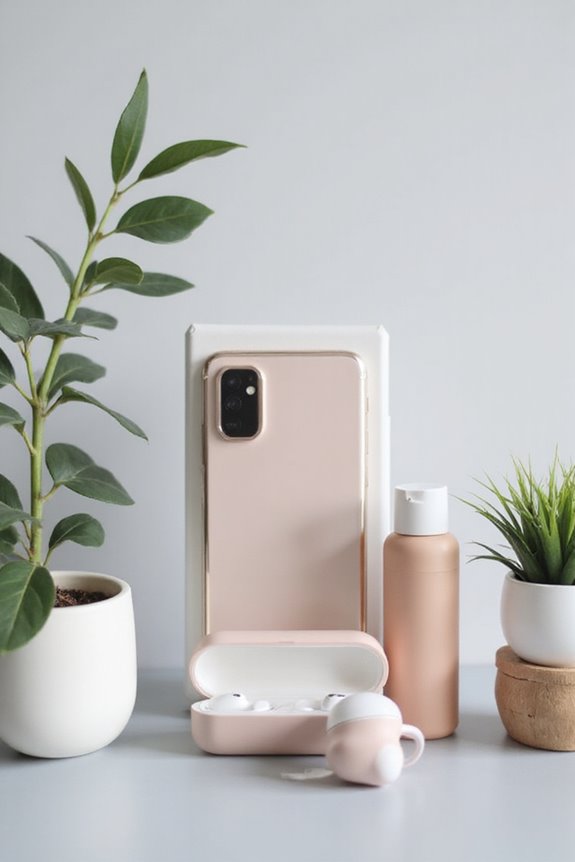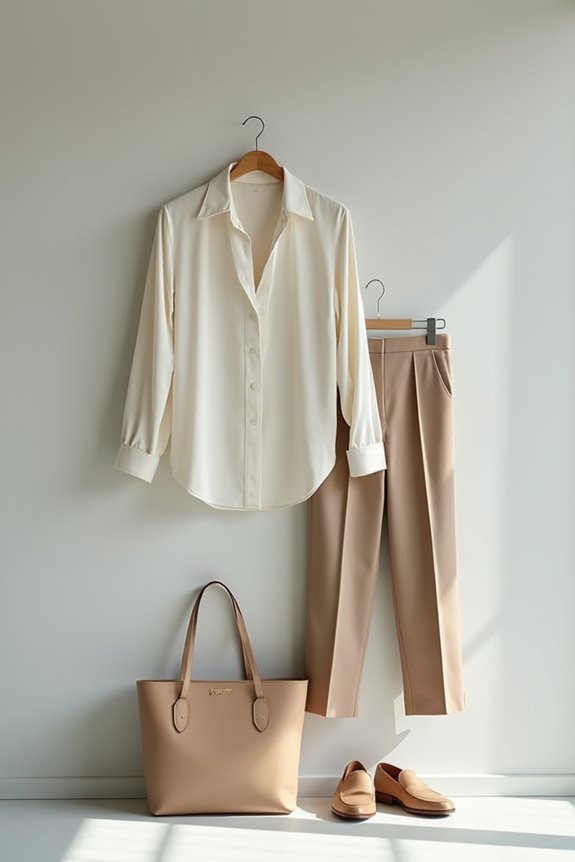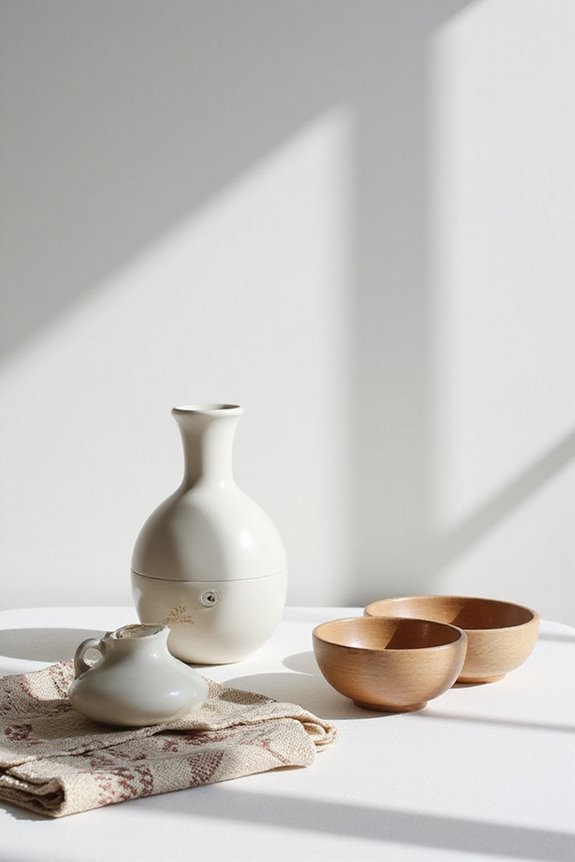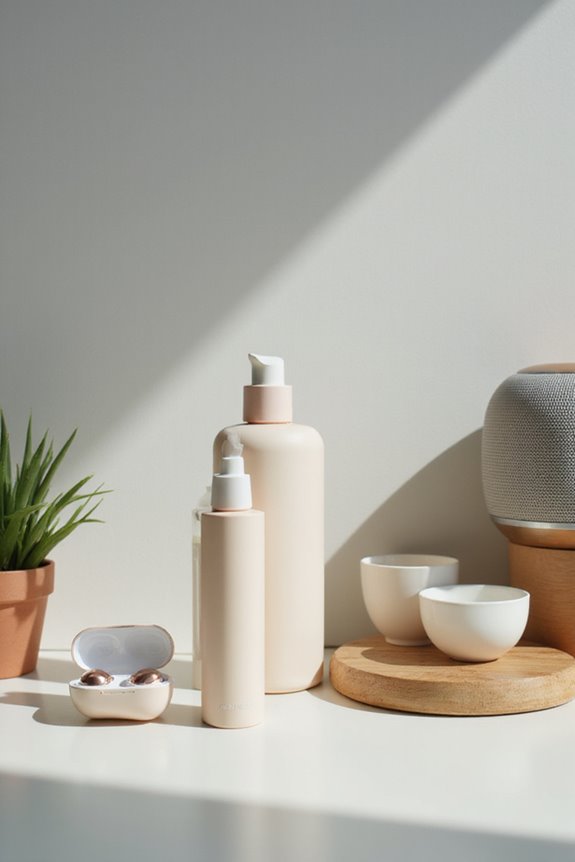To decorate a Korean minimalist home, we should focus on natural materials like light-colored woods and ceramics, using clean lines to enhance the overall aesthetic. A neutral color palette with shades of beige and gray creates a calm atmosphere, while thoughtful lighting design maximizes natural light and incorporates layered fixtures. Selecting multi-functional furniture supports open layouts, and integrating traditional Korean elements fosters a unique cultural touch. By balancing these design principles, we can create a serene living environment. More insights await.
Key Takeaways
- Use light-colored woods, such as pine or oak, to create warmth and texture in furniture and architectural elements.
- Embrace open layouts with minimal furniture to promote mobility and reduce clutter while maintaining functionality.
- Opt for a neutral color palette with soft shades to establish a calming atmosphere throughout the space.
- Incorporate natural light through large windows and use layered, minimalistic lighting fixtures for a warm ambiance.
- Include traditional Korean elements like low-level furniture and handcrafted ceramics to enhance authenticity and artisanal qualities.
Emphasizing Natural Materials in Your Space
Creating a serene living environment often starts with the careful selection of natural materials, a cornerstone of Korean minimalist design. Wood accents play a crucial role, as they contribute warmth and texture to our spaces. By opting for light-colored woods like pine or oak, we can create an airy atmosphere that embodies tranquillity. Moreover, wooden furniture, featuring clean lines and simple shapes, should ideally showcase natural finishes, highlighting authentic textures and grains. This principle extends beyond furniture; architectural elements like beams and sliding doors, when crafted from wood, harmonize beautifully with nature. In addition, incorporating natural stone can enrich our environments, adding grounding and visual contrast, while maintaining the understated elegance essential in this design approach.
Committing to Minimalism for Clarity
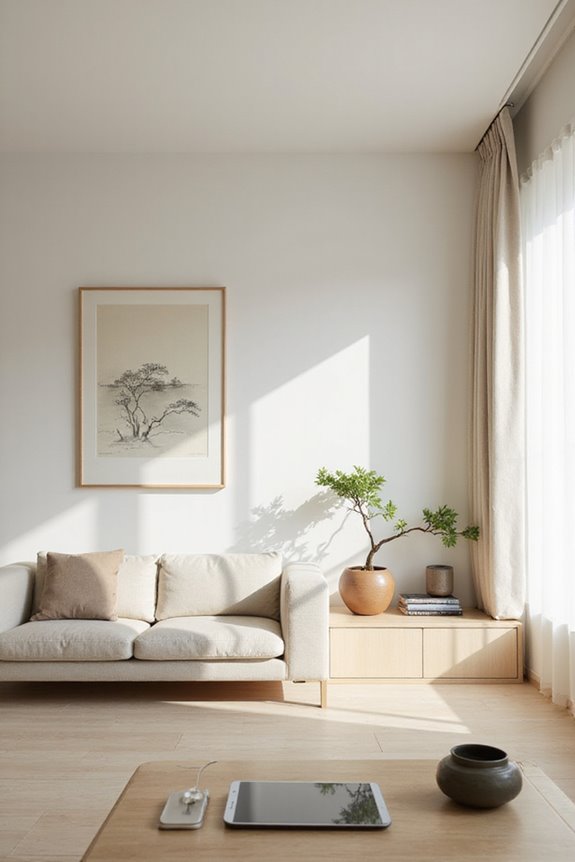
While minimalism might seem straightforward, committing to this design philosophy requires a thoughtful approach to guarantee clarity within our spaces. We should aim for functional decor, ensuring each item serves multiple purposes, which helps with clutter reduction. For instance, selecting furniture with simple lines not only enhances the aesthetic but also contributes to practicality. Hidden storage solutions can keep everything organized, thereby maintaining a clean environment. Additionally, we must avoid excessive decorations that can lead to visual clutter. An open layout allows for effortless movement and a sense of connectivity, effectively utilizing space. By focusing on these principles, we create a minimalist home that is both serene and functional, serving our needs without overwhelming our senses.
Choosing a Neutral Color Palette
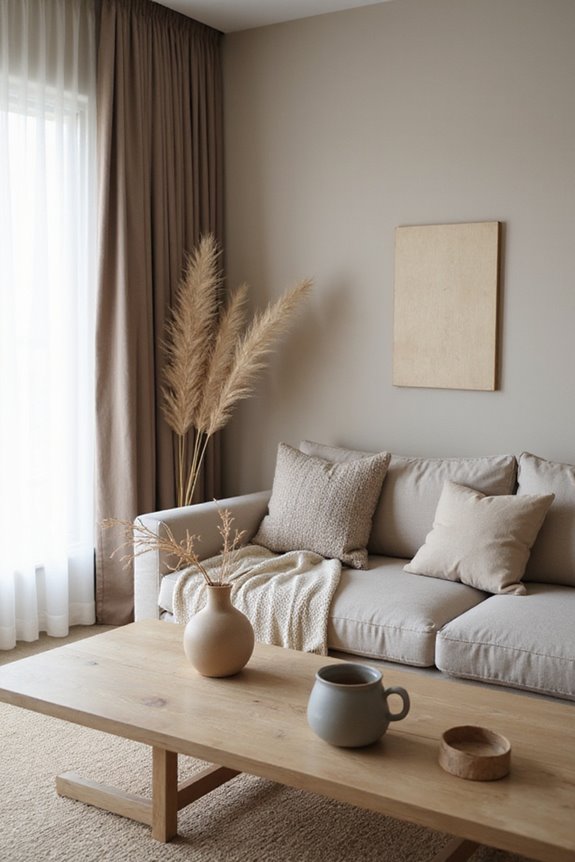
Choosing a neutral color palette is essential for embodying the principles of Korean minimalism, as it establishes a calm and cohesive atmosphere within our homes. Mainly featuring shades like white, beige, gray, and brown, this palette forms the base, fostering color harmony that enhances our environment’s tranquility. Soft pastel variations, such as light grays or blush tones, are particularly effective in spaces like bedrooms, promoting relaxation. These neutral backgrounds also serve to highlight natural materials—think unpainted wood or woven fabrics—while allowing for occasional subtle pops of color in accent pieces like cushions. By integrating a neutral palette, we create visually expansive rooms that reflect serenity and balance, aligning with the minimalist aesthetic fundamental to this design style.
Thoughtful Lighting Design for Ambiance
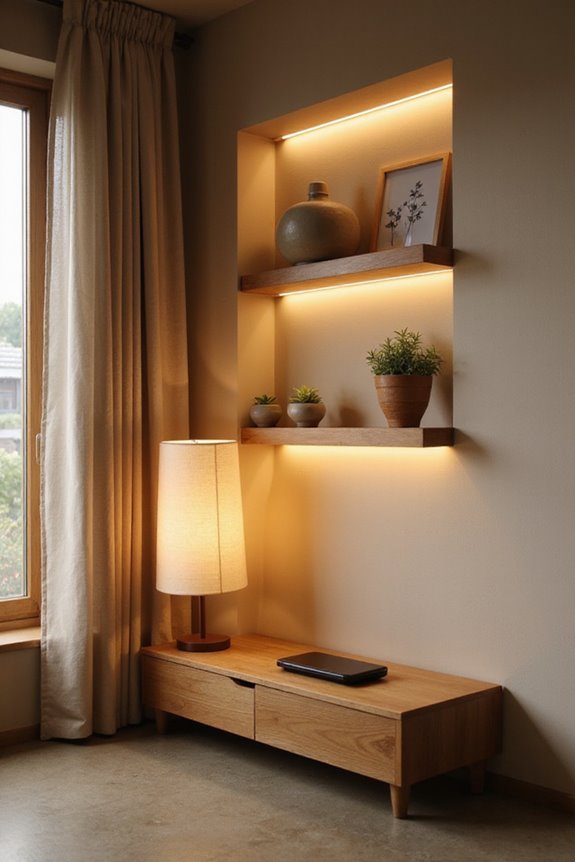
A well-considered lighting design is pivotal in enhancing the ambiance of a Korean minimalist home, complementing the previously established neutral color palette. By incorporating ambient lighting, we create a warm and inviting atmosphere. Utilizing large windows maximizes natural light during the day, reducing reliance on artificial options. At night, layered lighting with soft LED bulbs balances the space, providing versatility for various activities. Adjustable lighting fixtures and dimmer switches enhance lighting control, allowing us to tailor the environment to suit different moods. Minimalistic fixtures made from natural materials reinforce intentionality and maintain a clutter-free aesthetic. Finally, keeping our lighting discreet supports a serene atmosphere, harmonizing light and space while emphasizing the textures present in our home.
Creating Functional and Open Layouts
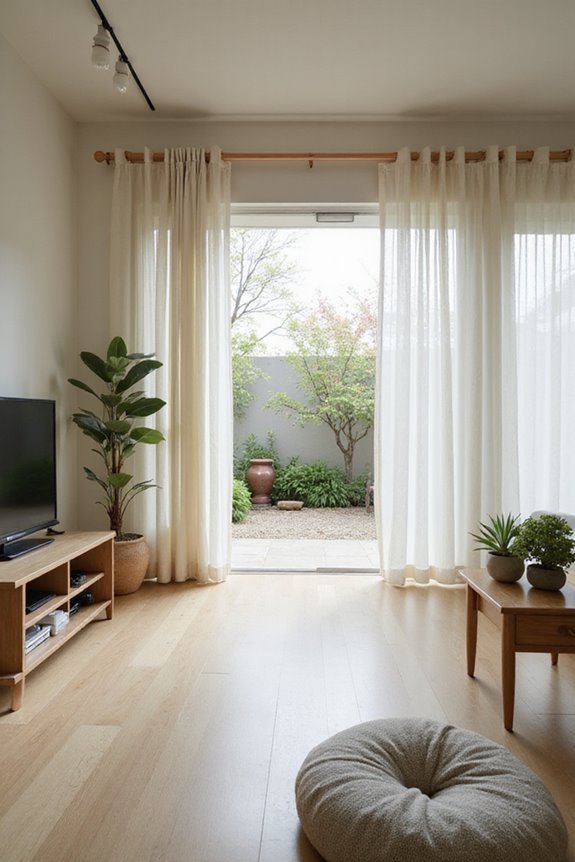
Creating functional and open layouts is essential for a Korean minimalist home, as it promotes both a sense of tranquility and efficient use of space. To achieve space optimization, we should select multi-functional furniture, like storage coffee tables and sofa beds, which help minimize clutter while maximizing utility. Implementing an open plan living design allows for seamless layout flow, enhancing the overall sense of continuity and fluidity within the space. Additionally, emphasizing natural light enhances the airy feel, making the environment more inviting. Integrating subtle textures and geometric shapes in our furniture choices can introduce depth without overwhelming the simplicity, maintaining the desired minimalist aesthetic, and ensuring everything works together cohesively for a harmonious living experience.
Integrating Traditional Korean Elements
When we look to integrate traditional Korean elements into our minimalist home, we enhance both aesthetic appeal and cultural significance. Utilizing wooden floors, reminiscent of hanok houses, and installing sliding hanji doors creates warmth and flexibility, reflecting traditional architectural features. We can evoke cultural symbolism through low-level furniture and floor seating, promoting communal living, a key aspect of Korean homes. Incorporating natural materials, like clay or ceramic decorative pieces, links us to ancestral craftsmanship, while selecting subdued neutral color palettes echoes the calming tones found in traditional art. Ceramic serving plates featuring traditional motifs and soft linen accents bring visual interest and comfort. Through these elements, our space becomes a harmonious blend of minimalism and rich cultural heritage, ensuring a tranquil atmosphere.
Selecting Multi-Functional Furniture
Selecting multi-functional furniture is essential for optimizing space and enhancing functionality in our Korean minimalist homes. By prioritizing space-saving solutions, we can choose pieces like sofa beds or coffee tables with built-in storage that serve multiple purposes. This approach not only reduces clutter but also maintains clean lines and visual harmony. When we look for versatile designs, selecting low-profile or stackable furniture will keep our rooms airy and spacious. Additionally, incorporating natural materials such as light wood or soft textiles aligns with the warmth and simplicity characteristic of Korean minimalism. Ultimately, well-crafted, multi-use furniture enhances daily living, supporting various activities while preserving the serene atmosphere central to our design ethos.
Incorporating Indoor Plants for Vitality
Adding indoor plants to our Korean minimalist homes not only enhances aesthetic appeal but also infuses our living spaces with energy and nature. With careful plant placement, we can maximize the benefits, using low-light tolerant options like ZZ plants in dim corners and brighter spaces for Pothos and Monstera. These selections improve air purification, fostering a healthier environment. To maintain visual harmony, we can choose decorative planters in muted tones that complement the minimalist aesthetic while showcasing the plants’ natural beauty. Additionally, incorporating larger-leafed varieties, such as Fiddle Leaf Fig, adds vibrancy without overwhelming the space. By integrating plants thoughtfully, we align with the Korean philosophy of balance, enhancing our connection to nature while cultivating tranquility within our homes.
Balancing Textures for a Grounded Atmosphere
Achieving a balanced atmosphere in our Korean minimalist homes requires thoughtful integration of various textures, which complement the overall design without overwhelming it. We can utilize texture layering to create depth by combining smooth surfaces, like concrete or plaster walls, with organic wooden accents and woven materials. Incorporating items such as rattan baskets and stone decor introduces tactile contrasts, adding both warmth and visual interest. Mixing heavy textiles, like wool rugs, with lighter options, such as linen throws, enhances comfort while maintaining cohesion. Additionally, using handcrafted ceramics further enriches our aesthetic, introducing artisanal qualities. By avoiding excessive accessories and embracing open space, we allow each textured element to breathe, resulting in a serene and inviting environment that reflects true minimalist principles. Introducing high-quality ceramics like Korean soup bowls can also enhance the overall texture and functionality of the space.
Frequently Asked Questions
How Do I Maintain Indoor Plants in a Minimalist Home?
To maintain indoor plants in our minimalist home, we prioritize low-maintenance species and focus on plant care. By simplifying our gardening approach, we keep our space serene while ensuring our plants thrive beautifully.
What Are Budget-Friendly Options for Korean Minimalist Decor?
When considering budget-friendly decor, we can explore DIY projects and thrift finds. These options allow us to create a Korean minimalist aesthetic by blending functionality with simple elegance, all while staying within our budget.
How Can I Personalize a Minimalist Space Without Clutter?
It’s ironic, isn’t it? To truly personalize a minimalist space, we should choose only a few meaningful art pieces and personal items that resonate with us, allowing the rest of the space to breathe and feel intimate.
Are There Specific Colors to Avoid in Korean Minimalist Design?
When considering colors to avoid in Korean minimalist design, we should focus on color psychology and design principles. Bright, saturated colors disrupt serenity, while clashing combinations hinder the balanced atmosphere we aim for in our spaces.
What Traditional Korean Crafts Can Enhance Minimalism?
When we consider traditional Korean crafts enhancing minimalism, Hanji paper’s delicate designs and Celadon pottery’s serene hues seamlessly support simplicity. Both add cultural charm, crafting calmness and cohesion in our minimalist spaces while celebrating classic artistry.


